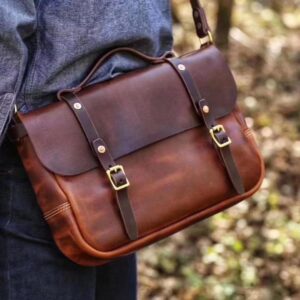Full Grain and Genuine Leather: Understanding the Difference.
- Full Grain Leather: A Commitment to Authenticity and Sustainability
- Definition: Full grain leather leather is the highest quality, made from the top layer of the hide, with all the natural grain intact. Its minimal processing preserves the hide’s unique imperfections and textures, making it a preferred choice in sustainable leather. Unlike other types, full grain leather is natural and durable, developing a rich patina over time, which adds character and longevity. It aligns with sustainable leather manufacturing by requiring fewer chemical treatments and maximizing the use of the hide, reducing waste.
- Quality: Full grain leather represents the best in sustainable leather. The tightly woven fibers result in superior strength and resilience, ideal for products meant to last for decades. Its natural imperfections enhance its authenticity, and over time, it develops a unique patina, one of the core full grain leather benefits. This natural aging process, coupled with its minimal treatment, makes full grain leather a symbol of eco-conscious luxury.

Full grain leather - Durability: One of the main full grain leather benefits is its exceptional durability. The leather’s tightly packed fibers resist wear and tear, ensuring it ages beautifully instead of wearing out. Full grain leather is ideal for products that require long-lasting performance, like shoes, bags, and furniture. Its durability also aligns with sustainable leather practices by reducing the need for frequent replacements, minimizing waste.
- Breathability: Full grain leather is naturally breathable, thanks to its intact pores. This quality allows air to circulate, making it comfortable for items like shoes and clothing. It absorbs and releases moisture, helping to regulate temperature and prevent discomfort. This breathability enhances comfort and is a key feature of eco-friendly leather products, ensuring that they are both functional and aligned with sustainability goals.
- Genuine Leather: A More Processed Approach
- Definition: Genuine leather is a lower grade of leather that comes from the layers beneath the top grain. It is often heavily processed to remove imperfections, resulting in a smooth but less durable finish. While it is technically real leather, it lacks the sustainability and quality of full grain leather, often relying on chemical treatments that contradict sustainable leather manufacturing practices.
- Quality: Genuine leather can be deceiving in terms of quality. Its highly processed surface may look polished, but this comes at the cost of the leather’s natural strength. While it might serve short-term needs, genuine leather lacks the enduring character and full grain leather benefits of strength, longevity, and a natural patina.

Full grain vs genuine leather - Durability: The heavy treatments used to create genuine leather weaken its structure, making it prone to cracking and peeling over time. Its lack of durability makes it less sustainable, as products made from genuine leather are often replaced more frequently, contributing to waste. Full grain leather, by contrast, is designed for longevity, making it the more eco-conscious choice in line with sustainable leather principles.
- Breathability: Genuine leather is often less breathable due to its treatments. Its surface coatings block the natural pores, reducing airflow and comfort, particularly in products like shoes or clothing. This lack of breathability contrasts with the performance of eco-friendly leather products made from full grain leather, which offer natural moisture management and comfort.
- Key Differences in Sustainability
- Full grain leather is the clear winner when it comes to sustainable leather. Its minimal processing and long-lasting durability make it a responsible choice for those seekingeco-friendly leather products. By choosing full grain leather, consumers invest in products that improve over time, support ethical manufacturing practices, and reduce environmental impact.
- Genuine leather, while often more affordable and polished in appearance, does not offer the same longevity or sustainability. Its reliance on chemical treatments and reduced durability makes it less aligned with sustainable leather manufacturing principles. For those looking to make eco-conscious choices, full grain leather remains the superior option for quality, durability, and breathability.
Cost and Value Analysis of Full Grain vs. Genuine Leather.
Full grain leather, though more expensive upfront, offers significant long-term value, particularly in the context of sustainable leather. Its durability and ability to age gracefully through natural patina development ensure that products made from full grain leather last for decades. While the higher initial cost may deter some, the overall value far outweighs genuine leather, which is less durable and requires frequent replacement. The use of vegetable-tanned leather in full grain products further enhances its eco-friendly appeal by minimizing harmful chemicals, reducing the leather environmental impact.

In contrast, genuine leather is more affordable but often compromises quality. Its heavy processing weakens the leather’s structure, leading to shorter product lifespans. Although it may seem cost-effective, genuine leather is prone to cracking and peeling, necessitating more frequent purchases. This not only increases long-term costs but also contributes to a higher environmental impact.
For those seeking eco-leather options, alternatives like recycled leather, upcycled leather, and organic leather provide a middle ground between cost and sustainability. These options reduce waste while offering similar aesthetics, aligning with sustainable leather production methods. In the end, full grain leather provides greater value in both durability and eco-consciousness compared to genuine leather.

